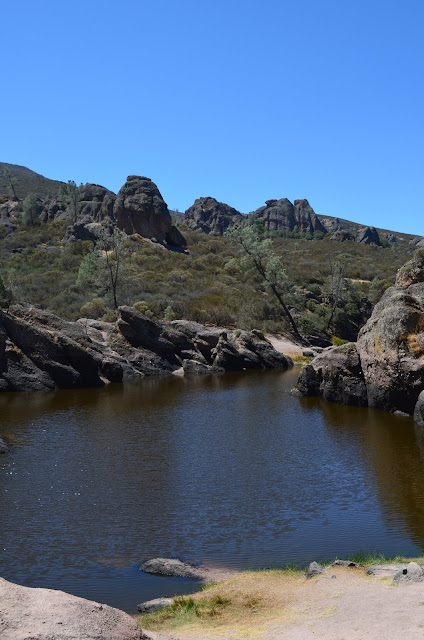 |
| Pinnacles National Park, photo by Kelly Wohlwend |
I went to Pinnacles hoping to see a California Condor and of course to experience a unique national park in the middle of California. The temperature was well into the 90s so a stroll/crawl/climb through a cool cave sounded like a refreshing idea.
We went on the Moses Spring - Rim Trail loop hike. This hike is a little over 2 miles with a moderate amount of elevation gain and a modest amount of stairs as you travel through the Bear Gulch Caves. I was there in August, which meant the Bear Gulch Caves were only partially open to protect the bats.
I was truly surprised at the amazing birding at Pinnacles on a hot summer day.
(* represents first time sightings)
Pinnacles Bird Count:
Acorn woodpecker* Pacific-slope Flycatcher
Bewick's wren Scrub jay
California quail Spotted towhee
California towhee Stellar's jay
Canyon wren* Turkey vulture
Chickadee (vocal only) Western tanager
Dark-eyed junco White-breasted nuthatch*
Hairy woodpecker White-throated swift*
Nuttall's woodpecker* Wild turkey
Wrentit
 |
| Acorn woodpecker by Kelly Wohlwend |
The males and females look very similar. The males have a larger red crest on their heads. They are definitely unusual birds that sport a clownish face and pale eyes. We spotted more of them at the picnic area that we walked through on our way to the main trailhead for the Moses Spring - Rim Trail loop. This picnic area was one of the best places for birds on my journey!

You're probably wondering...did I see a California condor? Unfortunately...I did not. The condors of Pinnacles are free flying birds, which pretty much means they do what they want, when they want and where they want. The best place to see them is the High Peaks but the trail to get there is long, very strenuous and I wasn't tempted in 90 degree weather despite my love of birds. It is a great reason to return to Pinnacles!
After traveling through the coast live oaks, surrounded by flycatchers, juncos and chickadees we entered the Bear Gulch Caves. Don't expect to find many birds in here...but bats! We didn't see the bats because they are huddled up in the closed areas but it was definitely fun to navigate the cold, dark caves.
 |
| Moses Spring Reservoir, photo by Kelly Wohlwend |
 |
| Canyon wren, photo by Mike Forsman |
Before I left I noticed birds flying over my head. They were larger than swallows and had a white throat and white patches on their back that comes down their sides. Similar to a tree swallow that has white rumps, the white-throated swift has white hips but the white throat is distinctive. As soon as they appeared, they were gone.
On the way down the Rim Trail I saw a wrentit and female western tanager but what I was seeking was the canyon wren. At the base of the trail I heard a very loud bird song. I had listened to the song of the canyon wren on my birding by ear CD many times but I have never heard it in person. I was hoping the sweet descending warbler like song I was listening to was the canyon wren. I took a detour on my way back and went up the same trail I was on before. I heard the bird sing down in the canyon and then I saw it! It disappeared before I could grab my camera. Hoping it would return I got my camera ready and I waited...about five minutes later it appeared. I fumbled with my camera and before I could get the camera to my eye and the cap off the bird was gone. I was never able to get a photo...so I plan to draw a picture...stay tuned.
 |
| White-breasted nuthatch, photo by Kelly Wohlwend |
 |
| Nuttall's woodpecker, photo by Kelly Wohlwend |
As I made my way to the car I spent a few last moments watching the comical acorn woodpeckers as they rotated their acorns, chattered to each other and gracefully glided from tree to tree.
I kept my eyes on the sky for a condor but one never made an appearance. For such a large bird it's amazing they can be so elusive. But don't worry...one day I will add the California condor to my list!
 |
| Pinnacles National Park photo by Kelly Wohlwend |
